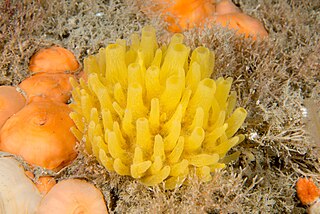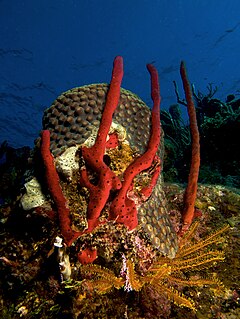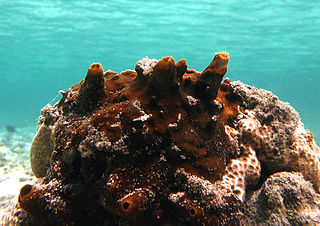
Polymastia is a genus of sea sponges containing about 30 species. These are small to large encrusting or dome-shaped sponges with a smooth surface having many teat-shaped projections (papillae). In areas of strong wave action, this genus does not grow the teat structures, but instead grows in a corrugated form.

Halichondriidae is a family of sea sponges belonging to the order Suberitida. These sponges have a skeleton consisting of dense bundles of spicules occurring in a more or less random pattern.

Halichondria is a genus of sea sponges belonging to the family Halichondriidae. These are massive, amorphous sponges with clearly separated inner and outer skeletons consisting of bundles of spicules arranged in a seemingly random pattern.

Spongia is a genus of marine sponges in the family Spongiidae, originally described by Carl Linnaeus in 1759, containing more than 60 species. Some species, including Spongia officinalis, are used as cleaning tools, but have mostly been replaced in that use by synthetic or plant material.

Plakinidae is a family of marine sponges. It is composed of seven genera:

Axinella is a genus of sponges in the family Axinellidae first described in 1862 by Eduard Oscar Schmidt. Species of Axinella occur in the Indian and Pacific Oceans. Most of these sponges are smaller than 20 cm, and have a yellow or orange colour.
Stelletta is a genus of sea sponges belonging to the family Ancorinidae.

Cliona is a genus of demosponges in the family Clionaidae. It contains about eighty described species.
Thoosa is a genus of sea sponges in the family Thoosidae. This genus is known for boring holes in corals. It contains sixteen described species.

Clathria is a large genus of demosponges in the family Microcionidae.

Haliclona is a genus of demosponges in the family Chalinidae.

Amphimedon is a genus of sponges with over 60 described species. In 2009, Amphimedon queenslandica was the first species of sponge to have its genome sequenced.

Aplysina is a genus of sea sponges in the order Verongiida. It was first authenticated and described by Giovanni Domenico Nardo in 1834.

Tedania is a genus of sea sponges in the family Tedaniidae.

Mycale is a genus of demosponge with 240 recognised species in 11 subgenera. It has been a large genus with multiple subdivisions since it was first described in 1867.

Dysidea is a genus of sponges belonging to the family Dysideidae.

Acarnus is a genus of sponges belonging to the family Acarnidae. The genus has almost cosmopolitan distribution.

Spheciospongia is a genus of sponges belonging to the family Clionaidae.

Plakortis is a genus of marine sponges in the order Homosclerophorida, first described by Franz Eilhard Schulze in 1880.















